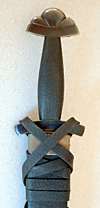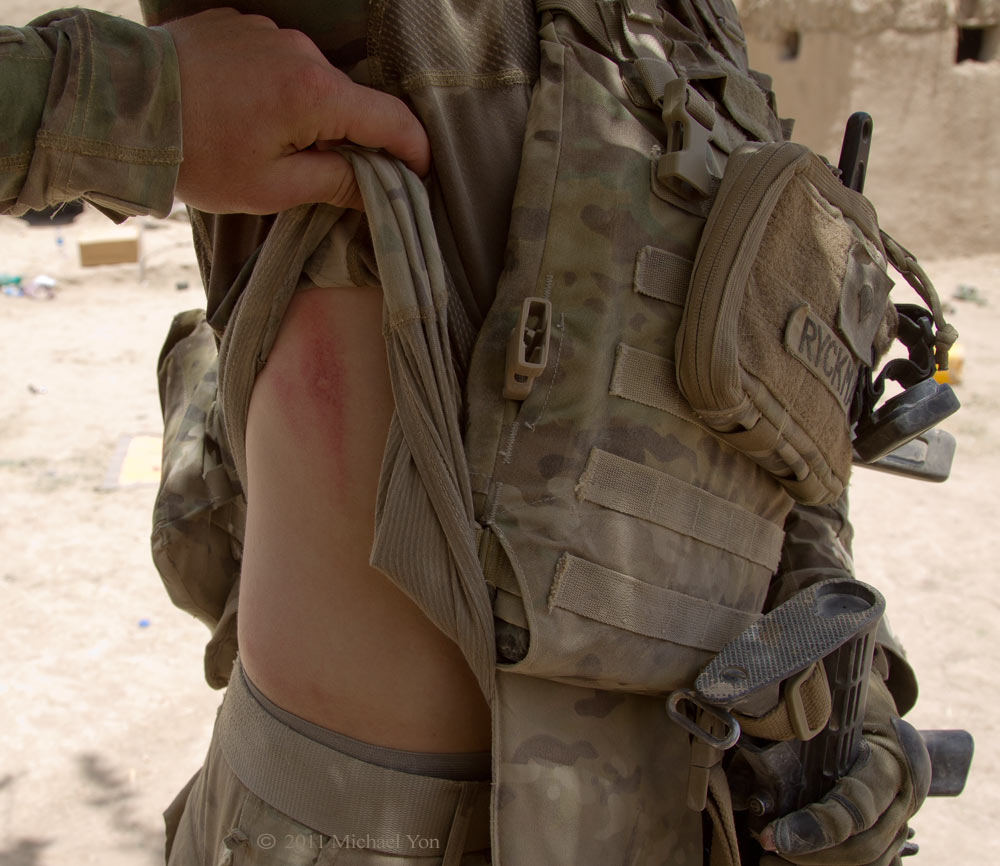In my last two posts, we discussed the
Super Edge Protection system I designed, where armor is given an Edge Protection (EP) value in addition to its DR. This allows people to be hurt without their armor being penetrated, which was before a physical impossibility. Similar to the
problems I outlined in the foreword, high-tech armor in GURPS is extremely binary - either a few points of damage get through an armored vest when its wearer is shot, or nothing gets through at all.
It's true that high tech flexible armors have higher DR values, so it's possible to suffer blunt trauma if riddled with submachinegun fire while wearing a kevlar vest, unlike the low-tech armor, where any significant amount of blunt trauma is a physical impossibility. However, in GURPS, a character can receive three high-damage rounds of 9x19mm Parabellum to the sternum and suffer only 3 points of damage - and a character in trauma plates can be shot repeatedly in the chest over and over and never suffer any ill effects, at least not until the trauma plates break (if you're using the optional degradation rules, that is) and they're shot 'for real'. But shouldn't someone who receives a powerful shot to the solar plexus feel some ill effects? Surely, all that energy from the bullet can't simply "go away".
So, could high-tech armor benefit from the SEP approach?
SEP was designed to remedy a deficiency in low-tech armor, not the high-tech stuff we use today, and because of this SEP doesn't immediately transfer well to high-tech armor. This is for a simple reason; the DR values of the low-tech armor are
too low, allowing a spear to penetrate well made chainmail or plate armor often in the hands of a strong user, which is physically absurd when one thinks about it. A metal weapon cannot easily penetrate metal armor without serious positional advantages. However, the DR values for modern, high-tech armor given in the GURPS sourcebooks are
spot-on accurate, and calibrated to be almost exact with regards to the item's defensive abilities versus small arms fire, so 'adding on' EP to the end of the scale wouldn't make sense.
For instance, an M16 does 5d6, and a regular SAPI (2000 era) combined with an Assault Vest, both from High Tech, gives DR 35 (12 for the vest + 23 for the plates). Thus, it is completely proof against 5.56mm fire, which can do 30 damage maximum. Barring any critical hits, the vest will resist the first shot, and probably several shots after that. However, it won't resist 12.7mm fire (6d6x2)! This is perfectly in line with the real world, so taking a multiplier of the armor's DR would make the vest far too strong and let it shrug off threats that it realistically can't handle.
So, we're going to have to go back to something more similar to
the original GamesDiner approach, where we take a certain fraction of the armor's DR and
replace it with EP. But before we do that, let's pose a question:
How much blunt trauma will an average user really suffer in a modern ballistic vest? This is something that is a field of emerging research, and I am continually shocked by how many of my fellow civilians do not understand how serious of a problem blunt trauma through armor still is, even in a modern context.
BABT and You
The process of suffering blunt trauma through modern ballistic armor has been termed
BABT, which stands for
Behind Armor Blunt Trauma.
It is a very new field of study, by definition not having existed until ballistic armor came into wide usage, and so we don't have a huge amount of data on it yet. However, the basic facts are known and have been shown in both studies and in real field service and experience.
The easiest way to understand this is to think of a piece of armor as a soccer net. A ball (the projectile) is kicked into the net, and the ropes, weaved together in a latticework, catch and
spread out the energy of the ball. What would have snapped a single line is caught and stopped by many spreading the energy out between them. None of the
energy of the shot has simply "gone away", it has simply been
spread out. It's possible for a well made net to spread things out so much that a person standing behind the goal wouldn't take any injury even if the soccer ball were to contact his body, but it's no guarantee - after all, soccer balls come in at varying amounts of force.
Most modern vests - whether rigid or soft - are required to display some resistance to blunt trauma. Yet there are many times even well made vests are hit by a square shot and their wearer has suffered injury, sometimes even death. Occasionally a shot into soft armor will be 'stopped' but
still penetrate into the wearer, like on the image to the right, which would require surgical removal of the bullet and vest. Rigid armor cannot have this happen, but is still only somewhat better on the blunt trauma front.
A 2006 study reported that at close range, an average 7.62mmR bullet versus a trauma plate presents a 50% chance of serious rib fracture and internal bleeding - the image at the start of this section illustrates x-rays of their human substitute as he is hit.
I'm not kidding when I say that sometimes being shot in a modern vest, even a rigid vest, can be the equivalent of getting smashed in the gut with a mace.
Of course, it's possible to get lucky and get off with some minor bruising. And there seem to be far more bruises than rib-smashing impacts with regards to pistol rounds versus pistol vests, for example.
A study on police officers who were shot primarily with pistols shows that serious injury only occurred in about 15% of cases. Yet we must consider it a very real possibility, and we also must consider that many shots in an average police gunfight are at an angle or wildly off-center, so many of the results in that study will have been glancing hits to start. Even those officers that were not seriously hurt were often knocked down or spun around.
In addition to all of that, military forces on the ground have for a long time known that being shot is not a pleasant experience. One soldier reported that being shot in his side SAPI
was as painful as being stabbed. Other soldiers have been
recorded falling in momentary pain and shock after being shot, only to immediately get back up. While it's true soldiers have reported rounds bouncing off their vests without anything more than discomfort, it's fairly clear that it's a roll of the dice as to how bad, and how painful, a given impact will be, and whether you'll be able to stay standing at the end of it.
It's for these reasons I think that ballistic armor in GURPS, whether rigid or soft,
should never leave you with the ability to simply "laugh off" bullets. Ballistic armor gives you a much better chance of survival, and often means you can get right back up again, but being shot often makes one fall down and scream in agony even the same.
Usage
So, how do we adapt the SEP system in such a way that blunt trauma through ballistic armor is simulated, even if only roughly? Fortunately, a rough implementation is very easy to put into practice:
-
Flexible ballistic armor has 2/3rds of its DR converted into EP (round up). This would render a DR 12 vest into DR 4, EP 8. This means a major wound is possible if higher than average damage is rolled, but not on the average roll.
-
Rigid ballistic armor, like a trauma plate, has 1/3rd of its DR converted into EP (again, rounding up). This would render a DR 35 trauma plate into DR 23, EP 12.
-
When dealing with combined forms of armor, such as a trauma plate inside of an assault vest,
add the EP values together and compare the remaining damage to the EP
after the shot contends with each layer's DR separately. This is to make sure that different layers of armor actually work together properly to help stop shots, as otherwise each layer would break in sequence instead of working together to absorb force.
Example: Fred the Infantryman is shot for 30 damage in the vitals, close to maximum damage! He is wearing an assault vest (DR 4, EP 8 and a SAPI plate (DR 15, EP 8). The shot first contends with the trauma plate, which subtracts 15 points of damage, leaving 15 left over. Then the shot contests with the vest, which subtracts 4 points of damage, leaving 11 left over. The remaining 11 is compared to the total EP value (8+8, for EP 16).
Since the damage is less than the combined EP from all layers of his armor, the shot does not penetrate, and the 11 points of damage are converted to crushing
. Fred is saved from a killing shot.
To show why doing it the 'regular' way won't work, consider: If the layers are treated separately with regards to EP, the SAPI plate absorbs 15 points of damage, and then compares the remaining 15 with its EP of 8, which means the trauma plate breaks. The remaining 15 points of damage are then compared to the assault vest's DR 4, EP 8. The remaining 11 points of damage breaks through the vest as well, killing poor Fred. This is at odds with reality, as even the original SAPI, working in concert with a ballistic vest, can easily stop a 30-damage shot.
-When dealing with alternate DR values for different attack sources,
apply the same rule to them. For instance, an assault vest would have DR 4 against a knife attack or a swung mace in regular High-Tech rules, so under this rule that would become DR 1, EP 3, allowing an 'average' knife attack to be shrugged off, but little else.
-
Stab vests and other melee resistant armor should use the regular SEP system, treating themselves as cloth armor, unless the GM wants to avoid extra complexity. This is because DR 5 is too low to represent how an average stab vest functions - a GURPS character can break that by rolling max damage, when
many real stab vests are capable of handling things off the end of the scale. If the GM desires to avoid excess complexity, simply treat them as flexible armor, as found here.
This system has the very nice effect of neatly simulating how armor behaves when struck by a threat too intense for it. In regular GURPS, a DR 12 pistol vest knocks off 12 damage even from rifle rounds, when in real life, a pistol vest confronted by a rifle round stops very little, if any at all, of the incoming round's velocity before it breaks. Here, it would only knock off 4 points of damage, with the majority of the vest's potential going to waste - this means a pistol vest will not help you survive against rifles!
This approach still has the same problem as the original low-tech SEP system, as it's still a bit too easy to kill someone through armor. Sadly, without changes to the injury rules, it's difficult to give an armor wearer a major wound that means he will fall to the ground for a moment without risking killing him with several shots. This means a story like that of
Paul Ray Smith is very hard to duplicate - for a man to take 13 rifle rounds to the chest and back would require all of them to roll low damage, which is possible but unlikely.
Still, I think this system makes gunfights more interesting when armored soldiers cannot simply shrug off being hit. I am still working on these rules, and welcome any feedback or commentary on how to simulate BABT easily in GURPS. Keep on firing!

 The simple answer is is that people in the middle ages and Renaissance were intimately familiar with the realities of knife attack, and created entire systems of combat designed to deal with them, many of which involve grabbing and twisting knives out of the opponent's hand, sometimes from awkward positions in the midst of grappling. Fiore de'i Liberi's system of "covers" - Judo parries that lead to control of the attacking dagger arm - can be applied from any number of positions. The Judo Cross Parry on the right can be done sitting down, standing up, kneeling, or even on your back, and given the nature of knife fighting and assassinations, there are dividends in learning to do it in many of these postures. Being able to parry and disarm a knife attacker while you are immobile in any posture, including sitting, can save your life. It certainly saved Frizier's. How much would you wish to bet that Frizier, afterwards, would be very interested in studying this supposedly cinematic technique?
The simple answer is is that people in the middle ages and Renaissance were intimately familiar with the realities of knife attack, and created entire systems of combat designed to deal with them, many of which involve grabbing and twisting knives out of the opponent's hand, sometimes from awkward positions in the midst of grappling. Fiore de'i Liberi's system of "covers" - Judo parries that lead to control of the attacking dagger arm - can be applied from any number of positions. The Judo Cross Parry on the right can be done sitting down, standing up, kneeling, or even on your back, and given the nature of knife fighting and assassinations, there are dividends in learning to do it in many of these postures. Being able to parry and disarm a knife attacker while you are immobile in any posture, including sitting, can save your life. It certainly saved Frizier's. How much would you wish to bet that Frizier, afterwards, would be very interested in studying this supposedly cinematic technique?


















